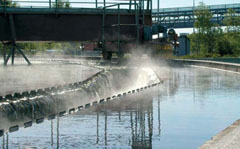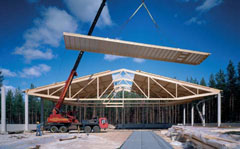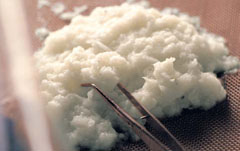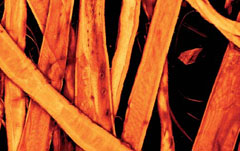| Friction forces relevant for papermaking
The aim of the study is to understand the friction phenomena that are important in flocculation, formation and strength development during the consolidation process. Another objective is to gain a deeper understanding of the rheological properties of coating colours.
Friction is important in papermaking, converting and end use of paper products. Specific examples were friction is important includes the web transport and the strength formation during consolidation. Friction and rheological properties of the coating colour are also important. Simulations have shown that the tendency of fibres to form flocs is a direct consequence of inter-fibre friction. It has also been found that polysaccharides like starch affect the friction between fibres and thus also runnability. Despite this fact there have been very few studies of friction forces in cellulose systems in aqueous media.
The process water is re-circulated to a high extent in a modern paper mill. This leads to enrichment of dissolved and colloidal substances (DCS) that are released from the pulp. The DCS contains lipophilic substances, like triglycerides, fatty acids, steryl esters and resin acids, and hydrophilic hemicelluloses, pectins and lignans. The effect of adsorbed lipophilic substances on friction forces between cellulose surfaces in air has recently been studied both on a microscopic level using the atomic force microscope and on a macroscopic level using a friction tester. However, the effect of liphophilic substances and dissolved carbohydrates on friction forces between fibres in aqueous media during papermaking has not been investigated.
In addition to fibres, fines and DCS released from the pulp, polyelectrolytes and fillers are added during papermaking. These additives also affect the friction forces present and rheological properties of the fibre suspension. The rheological properties of cellulosic fibre suspensions flocculated by polylelectrolytes have been studied earlier to some extent. On the contrary, there are only few direct studies on the effect of polyelectrolytes on the friction forces between cellulose surfaces in aqueous media.
Kinetic sliding friction forces on a molecular level will be studied using atomic force microscopy. The small-scale AFM measurements will be combined with studies of the rheological properties of the fibre suspensions and coating colour paste and macroscopic scale friction testing of wet sheets. The substances to be included in the experimental work are cellulose surfaces, the components of coating colour, extractives, dissolved carbohydrates and added polyelectrolytes and their possible complexes.
If the frictional and rheological phenomena during papermaking are understood, these may be optimized in a desired direction using added polyelectrolyte complexes.
Initial web strength additives The concept of initial wet web strength differs from wet strength because it refers to the strength of never-dried web. Initial wet web strength additives improve the machine's runnability. In general wet web strength additives do not cause permanent wet strength improvement but the wet strength is lost immediately after soaking the dried product.
The strength of a wet web is a result of physical and chemical interactions at the points of contact between the fibres. These interactions are strongly affected by pulp properties, moisture content and chemical additives. The pulp-related factors of importance of the strength of a wet web are the method of pulping, the pulp yield and the amount of chemical pulp present in the pulp mixture. Furthermore, refining enhances wet web strength because it leads to greater fibre conformability and a greater fibre-fibre contact area as well as higher specific bond strength. In addition, refining leads to an increase in the amount of fines that also increases the wet web strength.
The addition of certain polymers has been found to increase the strength of never-dried wet web. For example, chitosan, some polyamines and cationic aldehyde starch are known to enhance wet strength of never dried paper web. The addition of polymers introduces ionic or covalent bonds between the fibres and the polymers. The stronger the interfibre bonds the higher the strength of the wet web. However, the literature contains very little information on the effects of different chemical additives on the development of web strength.
The use of tailor-made polymers as initial wet web strength additives will be studied by applying adhesion measurements, dynamic mechanical analysis and more conventional paper strength testing.
The aim of the study is to get a deeper knowledge of the possibilities to increase the strength of wet paper, and hence, the runnability of paper machine in its wire and press sections. Other applications, such as cell wall strengthening of fibres, composite materials, are not excluded.
New furnishes consisting fibrils and fillers
It is hypothesized that new fibril and fibril/filler technologies will provide better paper product quality and generate new multilayered products or product modifications at competitive manufacturing costs without compromising the paper machine runnability. It is realized that dewatering of the fibril-containing web is one of the major technical challenges and therefore this is paid special attention. Another challenge is to develop practical ways of producing highly oriented multilayered webs.
A comprehensive understanding on the potential of the fibril and fibril/filler technologies in producing superior paper product performance will be obtained experimentally and through simulations. The most relevant subjects are related with the web formation and activation of the web during drying. These, together with the furnish, define the density, opacity, strength, stiffness, dimensional stability and other relevant properties of the end product.
The design criteria for laboratory and pilot scale unit processes will be examined and defined. A laboratory forming device for preparing oriented, multilayered sheets will be developed. The device will be used in verifying the simulation results on the optimal structure of the multilayered paper products.
Thermodynamic modelling of paper drying will be performed in order to optimise the drying process for the new paper grades. A simulation program for calculating the basic thermodynamics of paper drying will be developed. The drying coefficients (diffusion factors, heat transfer coefficients, thermal conductivity, etc.) of the new paper grades will be determined experimentally. The thermodynamic simulation program will enable the study of different drying conditions (temperature, surrounding humidity, pressure, etc.) and comparisons between different drying concepts.
The task ends at estimates on the suitability of the new fibril-containing paper and board grades for different applications and feasibility of their planned production processes.
Bio-based composite materials
The ever-increasing price of oil and demand on biodegradability may lead to new markets of wood and wood fibre based composites. So far the incompatibility of hydrophilic cellulose fibres with hydrophobic thermoplastics has been considered as a major obstacle for realization of the cellulose based composites.
Mechanical defibration of wood above the glass transition temperature of the middle lamella lignin produces hydrophobic lignin-covered fibres that could well serve as reinforcing elements in films of thermoplastic derivatives of starch. Structural composites could be engineered of highly oriented webs of lignin-covered fibres embedded in layers in the matrix of the thermoplastics. This concept of the new composite materials will be tested. Demonstrators showing possible innovative applications will be prepared as student project development project work.
Deep knowledge on the fracture mechanics of the composites will be gathered through light and electron microscopy and FEM analysis.
| 





